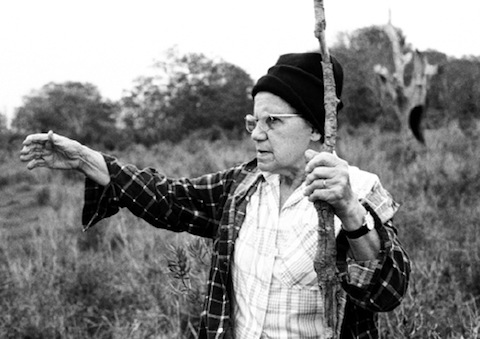Troubled Waters: Discussion with Louisiana Documentarian Monique Verdin
Monique Verdin is a documentary photographer and filmmaker who’s created a cinematic labor of love titled “My Louisiana Love,” which tells about the long legacy of cultural and environmental injustices in the state from a Native American perspective. She recently spoke with Bridge the Gulf and the Institute for Southern Studies for the report Troubled Waters: Two Years After the BP Oil Disaster, a Struggling Gulf Coast Calls for National Leadership for Recovery. Verdin discussed her process in creating the film, the threats to her Houma people’s traditional way of life, and the loss of her partner and how it impacted the film. “My Louisiana Love” is produced by Within A Sense, LLC, for a presentation of Native American Public Telecommunications, Inc. (NAPT).
Bridge the Gulf / Institute for Southern Studies: Tell us about the story inside of “My Louisiana Love.”
Monique Verdin: It’s a personal narrative that’s about my life and my family, specifically my grandmother, who turned 97 on Easter Sunday 2012. The cycle is that the land in the early 1900s was essentially stolen from the Natives living in the coastal communities of Terrebonne and Lafourche Parish, and then the oil and gas companies came in, the federal government came in, they put their pipelines in, and dug the canals. Then fast-forward into the ‘90s, and they’re dumping oilfield waste near the community of Grand Bois, which is Native American primarily. Then we have Katrina, and the grand finale is the BP drilling disaster. But the reality is, that’s probably not the finale. I mean, the injustice continues. We’re still faced with all of the issues of social and environmental injustice. It will be released some time this year. We finished in March 2012.
BTG/ISS: Talk about the process that led you into making the film.
Verdin: In 1998, I came home to South Louisiana. I had been living in Pensacola, Fla., on Santa Rosa Island. My mother moved there from Louisiana when I was five. As a child I thought of it as living in exile. I had a lot of asthma problems, and as soon as we moved to Pensacola those issues went away. I mean, we lived right next door to a natural-gas refinery, so you know, who knows if that was the issue or not?
I always vowed that I would move back to Louisiana, and as soon as I was old enough I did. Right around that time, 1998, my senior year in high school, I saw an Ed Bradley special, “Town Under Siege.” I remember my aunt calling me, like, “Oh, you need to watch this. Your cousin Clarice is fighting these oil pits.” Basically it was telling the story of the community of Grand Bois, which is on the border of Terrebonne and Lafourche Parish. And there’s a toxic waste facility there where they were taking hazardous material from Alabama and transporting it across state lines to Louisiana where it was considered nonhazardous and dumping it in these open waste pits. And it’s full of all this benzene and all these other chemicals I can’t even pronounce or know what they mean. But the community was getting sick. It was having very violent reactions. A number of different women had to have hysterectomies for the same kinds of issue. People were having nosebleeds and upper respiratory problems and all this craziness. So I remember seeing that and being like, wow, you know? And that kind of inspired me to pick up a camera.
You know, as a young woman I think that it was just overwhelming to see a culture so threatened but also so alive, you know? It’s still there, but it’s changed so much, just in the last 13 years of me photographing and seeing people change, and seeing as the old people die, you know, and the old ways are going with them, and these disasters, from tropical storms to hurricanes to drilling disasters to, you know, Walmarts popping up everywhere and that kind of mentality.
 Photo of her Grandmother Matine by Monique Verdin.
Photo of her Grandmother Matine by Monique Verdin.
So I started photographing in ’98 and doing a little bit of video – and all very personal, experimental, just learning how to use the equipment and also I think putting four lines around something to frame it and to look at it and digest it. It started raising a lot of questions, so I just continued. Then I met a man named Mark Krasnoff, who was very curious about the Native American community that I came from, and we started doing this video documentation. And then Katrina hit. When he passed I had 60 hours of tape and didn’t know what to do with it. And my best friend Sharon Linezo Hong was like, I’m going to help you finish this. It’s not just my story, and I mean that – like, even though it tells the story. It’s not just my story, and I mean that – like, even though it tells the story of my father and my grandmother and myself and Mark Krasnoff and other characters in my life but also I think it speaks to a Louisiana story of present day.
BTG/ISS: What do you want people to walk away from this film with? What do you hope it accomplishes?
Verdin: I hope that it is a testament to the people of south Louisiana. I think of myself as a recorder. I don’t have an agenda. I don’t know what the answer is. But I think it’s important for us to have a record, to be able to reference and be able to understand how we got here. And for the Houma, their history is untold. And my using my life and using my grandmother’s life and the story of the Houma people who were some of the first natives in the Mississippi Delta who are recorded in the journals of the Jesuit priest – to have their voice be heard on whatever small scale the film ends up reaching, or large, to have it there for my younger cousins to be able to look at and say, “Oh, OK, this is where we come from, this is who we are, this is how we got here, you know, this is what our people have been through” – that’s a really important thing for me.
I also hope that people recognize the significance of south Louisiana. We are facilitating the needs of a nation, and we have made the ultimate sacrifice, and we continue to make that sacrifice, and we’re not stupid people who live on the coast. We’re the blue-collar workers that are making it happen. And we have been up against discrimination, lack of education, environmental injustice – the list is long, and it hasn’t gone away.
BTG/ISS: What’s next for you after this film?
Verdin: I don’t know what’s next. In talking about doing outreach and strategic audience engagement and all of these kinds of ideas about, you know, traveling with it and sharing it with a larger community. And I love doing that, I love sharing, just slideshows of my photographs and talking to people about south Louisiana and, you know, making it relevant for them – I like to do it, but I want to be home. There’s this part of me that I just want to be home. And I also think that if there’s a way to use the film to get people to come to Louisiana, to know that, wow, this is a power point on the planet. We’re the seventh-largest delta in the world, and the delta is important for so many different reasons and it’s something that needs to be protected. Whether you live in Wisconsin or New York City or wherever, this is an important cultural, environmental and economic place, for the nation and for the international community. So I hope that yeah, I hope to continue the dialogue. I think that’s all I can do in my reality.
BTG/ISS: What’s the reaction to the film?
Verdin: I guess that for me it was really important for my grandmother to watch it and to see it, even though it was hard to show it to her because it’s her seeing her house that’s gone, her son that’s dead, and Mark Krasnoff, who was a good friend of hers, you know, and that whole trauma, and reliving that experience. But when it ends she says, “That’s for real, and people need to see that, because it’s for real.”
We are having a "sneak preview" screening on April 23th, 2012 at Nunemaker Auditorium at Loyola University, from 7:30 - 9. It’s being co-sponsored by the Center for New Orleans Studies and the Center for Environmental Communications and Mass Communication, so that will be the first time to show it publicly. I showed it here at the Gulf Gathering [a gathering of coastal restoration and environmental advocates], which felt like a really safe place to step out with it. People in the audience seemed to get it and felt it was an important story that should be heard. That made me feel good. You know, ultimately it’s like “OK, I’m ready to let it go and let it loose”. It doesn’t need to be held so close anymore. It’s for other people to see and to use. And hopefully for NGOs, like the Gulf Restoration Network, to be able to use, to share the story, to share a larger story and more information. Hopefully it will be used for that.
BTG/ISS: One more thing. Do you have any kind of advice or words of wisdom for other folks on the Gulf Coast who have a story to tell but not sure they know how to do it?
Verdin: I think it’s important for people to trust their gut instincts and to follow their heart. And if they feel or see or hear something that they think is important, to record it, though maybe you don’t use it for five, 10, 15 years, but to have that in the archive. Do it, record it, share it. And hopefully the Gulf South is better because of it. And you know, share the sad stories but also show the hopefulness and the reasons why it’s worth fighting for.
I nterview conducted by Ada McMahon. The transcript has been edited for clarity and length.
nterview conducted by Ada McMahon. The transcript has been edited for clarity and length.
Download the Troubled Waters report from Institute for Southern Studies.
Read and watch more interviews with Gulf Coast community leaders.
 This content was produced by Bridge the Gulf Project and the Gulf Coast Fund for Community Renewal and Ecological Health, in collaboration with the Institute for Southern Studies.
This content was produced by Bridge the Gulf Project and the Gulf Coast Fund for Community Renewal and Ecological Health, in collaboration with the Institute for Southern Studies.
